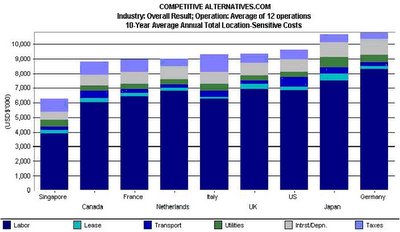If you could locate your new business anywhere in the world, where would you build it?
Global accounting firm KPMG International recently released its analysis of the Competitive Alternatives available to new business site selection teams around the globe (HT: The Tax Foundation). Here's KPMG's description of their study:
The study is an expansion and update of previous KPMG publications, and measures the combined impact of 27 significant business cost components that are most likely to vary by location. The study covers 17 industry operations in nine industrialized countries: Canada, France, Germany, Italy, Japan, the Netherlands, Singapore, the United Kingdom and the United States.
The basis for comparison is the after-tax cost of startup and operations, over 10 years.
Overall, what the study found is summarized in the following chart, which details the total annual cost comparison for the nations included in the study:
In reading the chart, we find that Singapore has, by far, the lowest costs for launching and operating a new business through its first ten years. The nations of Canada, France, the Netherlands, Italy, the UK and the US are all closely competitive in location-sensitive costs with one another, while Japan and Germany are substantially more expensive than the rest.
In other words, if the total cost of launching and operating a new business for ten years were the key driving factor in selecting the location of a business, in 2005, Singapore would win, hands down.
The decision of where to locate a business' operations is substantially more complicated, as total cost becomes just one of many considerations. Highly influential, but non-cost related factors include: location of major customers and competitors, location demographics, available infrastructure, etc.
Who might have guessed that the U.S. would have the third-highest costs of the world's major economies?
Welcome to the blogosphere's toolchest! Here, unlike other blogs dedicated to analyzing current events, we create easy-to-use, simple tools to do the math related to them so you can get in on the action too! If you would like to learn more about these tools, or if you would like to contribute ideas to develop for this blog, please e-mail us at:
ironman at politicalcalculations
Thanks in advance!
Closing values for previous trading day.
This site is primarily powered by:
CSS Validation
RSS Site Feed
JavaScript
The tools on this site are built using JavaScript. If you would like to learn more, one of the best free resources on the web is available at W3Schools.com.
